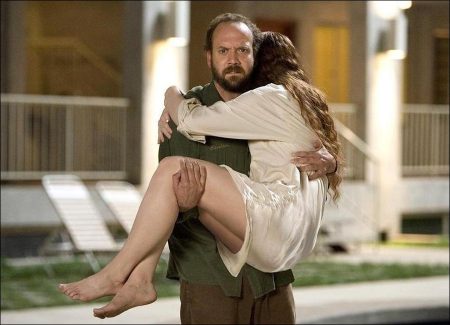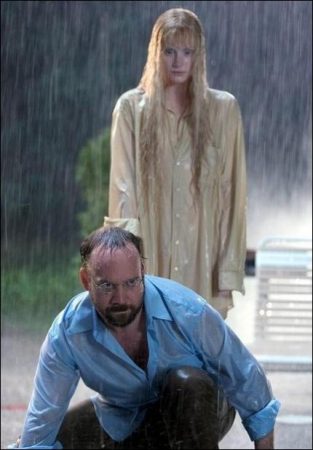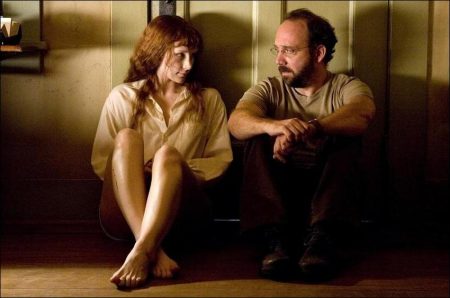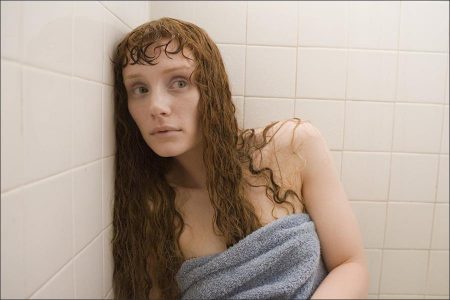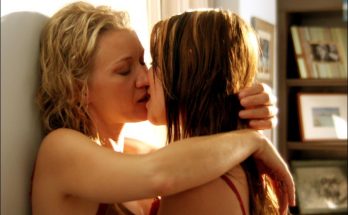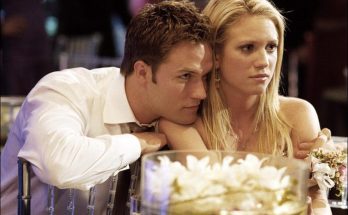Tagline: Some stories are real.
Lady in the Water movie storyline. Cleveland Heep (Paul Giamatti) has been quietly trying to disappear among the burned-out light bulbs and broken appliances of the Cove apartment complex. But on the night that irrevocably changes his life, Cleveland finds someone else hiding in the mundane routine of the modest building – a mysterious young woman named Story (Bryce Dallas Howard), who has been living in the passageways beneath the building’s swimming pool.
Cleveland discovers that Story is actually a “Narf” – a nymph-like character from an epic bedtime story who is being stalked by vicious creatures determined to prevent her from making the treacherous journey from our world back to hers. Story’s unique powers of perception reveal the fates of Cleveland’s fellow tenants, whose destinies are tied directly to her own, and they must work together to decipher a series of codes that will unlock the pathway to her freedom. But the window of opportunity for Story to return home is closing rapidly, and the tenants are putting their own lives at great risk to help her. Cleveland will have to face the demons that have followed him to the Cove – and the other tenants must seize the special powers that Story has brought out in them – if they hope to succeed in their daring and dangerous quest to save her world…and ours.
Lady in the Water is a 2006 American dark fantasy film written and directed by M. Night Shyamalan and starring Paul Giamatti and Bryce Dallas Howard. The film’s plot concerns the superintendent of a Philadelphia apartment complex who discovers a young woman in the swimming pool. Gradually, he and his neighbors learn that she is a water nymph (or Narf) whose life is in danger from a vicious, wolf-like, mystical creature called a Scrunt that tries to keep her from returning to her watery “blue world”.
This is Shyamalan’s first movie in which he has played a significant role as one of the supporting actors. The film received a negative response from critics; with criticism revolving around the film’s lack of consistency, characterization, and egotistical moves (Shyamalan casting himself as a messianic writer and the film critic as a one dimensional jerk), along with it being considered a comedy and not a drama.
In its opening weekend (July 21–23, 2006), the film grossed a total of $18.2 million, placing third in the United States box office results for that weekend. It was Shyamalan’s lowest opening for any of his five major films. As a result of the negative reviews and poor word-of-mouth, its second week fell sharply to $7.1 million, pushing its total to only $32.2 million. Its third weekend was no better, falling another 62.1% to $2.7 million. As of 2011, its total was $42.285 million. In addition, the film made only $30.5 million in the foreign box office, pulling its tally to approximately $72.785 million internationally.
The Worlds of the Cove
Lady in the Water was shot entirely on location in Leavittown, Pennsylvania, approximately 20 miles outside of Philadelphia, at the site of a former 3M tape manufacturing plant. The 81 acre property provided an area large enough to construct the film’s principal set, an expansive apartment building called The Cove, as well as warehouse space for interior sets, workshop and office space, and a massive water tank (previously used by 3M as a fire tank) for the underwater sequences.
The close proximity of the various facets of production on the compound made it possible for Shyamalan to shoot Lady in the Water in sequence. From the moment Cleveland introduces himself to Mr. Farber, the film was shot scene-for-scene as the story unfolds in the script (with the exception of the underwater sequences, which were filmed at the end of the production schedule).
The Cove – a U-shaped, 5 story, 57-unit apartment complex complete with a center courtyard, swimming pool and a detached bungalow bordering on a sprawling wooded meadow – was built from the ground up under the supervision of production designer Martin Childs.
Childs, an Oscar winner for his set designs for Shakespeare in Love, had never been to Philadelphia and drove around the city’s suburbs to absorb the architecture as he was researching and developing ideas for the look of The Cove, which Shyamalan envisioned as a “transitory” building housing tenants whose lives are in state of flux. “I tried to imagine the sort of social feel that a building like The Cove might have, with its residents from different ethnic backgrounds, of different ages and social classes,” Childs recalls.
Rather than create a stylized structure with inherent architectural ambience (like the foreboding atmosphere exuded by a Gothic building, for example), Childs and Shyamalan purposely chose a nondescript design for The Cove – one that would give no hint of the diverse worlds cohabiting within or portend the events to come. “We decided to create a completely ‘blank’ building that would be given character by the characters inside it,” Childs explains. “In a sense it was a blank page upon which the story could be written.”
A scale model was made of Childs’ design for the complex, which he and his team strategically placed on the 3M property where the massive set was to be built. Then they calculated how sunlight would fall onto the building from various angles. Using computer diagrams to chart the trajectory of the sun and how it changed the light flow onto the building, Childs determined how to best position and construct the horseshoe-shaped structure, with its “open end” facing what would become a wooded area.
The art department and construction team built and dressed the complex in seven weeks. Nine of the units were “built out” and fully dressed as the residences of the film’s principal characters. “The complex had everything but plumbing and heating,” confirms producer Sam Mercer. In fact, The Cove was so realistic, during production a memo was distributed to the cast and crew reminding them: Please do not use the sinks and/or bathrooms in the apartment sets. They may look real, but they’re NOT!”
As in the story, each tenant’s apartment is a microcosm unto itself, reflecting not only the character of the inhabitant, but how he or she relates to the outside world – from the warmth and tradition of Mrs. Choi’s home to the learned and solitary feel of Mr. Leeds’ bookish abode, to Mrs. Bell’s nurturing, animal-friendly environment or the lethargic, unstructured vibe of the Smokers’ apartment.
Childs and his art department so thoroughly outfitted the tenants’ living spaces, many members of the cast remarked that they became more deeply acquainted with and connected to their characters upon entering their apartments. Some reactions were more visceral than others; as Shyamalan recalls, “When I walked in the Smokers’ apartment for the first time it looked like somebody had vomited on the walls.”
The interior of Cleveland’s bungalow was built on stage as well as practically, with anonymity as a guide. “In Cleveland’s bungalow we wanted an absence of past because he keeps his past stuffed away and never talks about it,” says Childs of the caretaker’s modest surroundings. “There are some older items in there but those could easily be left by previous caretakers, like the filing cabinets. There’s nothing there to learn about Cleveland – unless you’re nosy, like Story.”
Vick and Anna’s apartment was also created as an interior set, along with The Cove’s mailroom, laundry room and basement hallways. These sets were built in life-size dimensions, without removable “fly walls” typical of most interior sets, in keeping with Shyamalan’s desire for authenticity. For a key scene that takes place in the mailroom, 20 cast members crowded into the tiny set along with key crew and equipment.
In designing Story’s secret alcove beneath the swimming pool, a set that was built and then submerged in the production’s massive water tank for filming, Childs found insight in a comment Story makes to Cleveland the first time she comes to his bungalow. “Story tells Cleveland that he has a beautiful sofa, but it’s actually quite ordinary,” the designer notes. “I got the idea that Story thinks The Cove is a pretty special place, so she decided to recreate something that looks a bit like it in the home she’s made for herself.”
Story’s niche is a treasure trove of shiny objects that she has collected during her stay. “She’s drawn to shiny objects but she doesn’t know their value,” Childs says, “so among the diamonds there are some scrunched up soda cans and a piece of tinfoil from Mrs. Choi’s orchid display.”
The swimming pool is not only Story’s conduit to and from the human realm, but it also serves as the nucleus between the rigid grid of the apartment complex, the organic world that is beginning to encroach upon it, and the mysteries of Story’s mythological home.
“The pool is the point at which all the worlds collide,” Childs observes. “On one side you have the man-made building. On the other side you have nature in the shape of the forest. Underneath you have Story’s world. So the pool is literally the heart of the building where all of these worlds meet.”
After construction, the pool was painted with gradations of color to add to its mystery – beginning with light blue at the top edges and deepening to a black-blue at the bottom. Shyamalan and Childs’ penchant for detail extended to the pool’s grill, which is based on the design of a sewer grate in a pivotal sequence from Alfred Hitchcock’s classic thriller Strangers on a Train, in which a character inadvertently drops an incriminating piece of evidence down the drain.
It is through this grate at the bottom of the pool that Cleveland discovers Story’s secret world beneath The Cove. Paul Giamatti and the dive team, led by stunt coordinator Jeff Habberstad, filmed these underwater scenes on two sets submerged in a 350,000 gallon water tank. Dubbed “Big Bertha” by the crew, the tank housed a 20-foot tunnel that Giamatti had to navigate in the dark with no breathing apparatus, as well as the set for Story’s alcove, which Cleveland discovers at the end of this long passageway.
“The first day we got in the pool to practice, he was completely natural,” says Habberstad of Giamatti, who impressed the stunt team with his ease in the water and his ability to hold his breath for long periods. “He even seemed to prefer to stay underwater between takes while we were preparing for the next shot.”
Habberstad developed Cleveland’s improvised breathing method – by which he breathes air from underneath Story’s collection of glassware with a straw-like tool – in his own swimming pool before teaching it to Giamatti. (The actor performed this stunt himself without a breathing apparatus or the benefit of special effects.)
“We were able to do things that we would not have been able to do with any other actor,” Shyamalan attests. “It was dangerous. Not only did Paul have to hold his breath as he was swimming and acting, but he couldn’t see very well because it was very dark in the tank and the water was filled with particles so that it would feel muddier and more organic. And I do long takes.”
Continue Reading and View the Theatrical Trailer
Lady in the Water (2006)
Directed by: M. Night Shyamalan
Starring: Paul Giamatti, Bryce Dallas Howard, Jeffrey Wright, Bob Balaban, Freddy Rodriguez, Sarita Choudhury, Cindy Cheung, M. Night Shyamalan, Mary Beth Hurt, Noah Gray-Cabey
Screenplay by: M. Night Shyamalan
Production Design by: Martin Childs
Cinematography by: Christopher Doyle
Film Editing by: Barbara Tulliver
Costume Design by: Betsy Heimann
Set Decoration by: Larry Dias
Art Direction by: Stefan Dechant, Christina Ann Wilson
Music by: James Newton Howard
MPAA Rating: PG-13 for some frightening sequences.
Distributed by: Warner Bros. Pictures
Release Date: July 21, 2006
Views: 165
